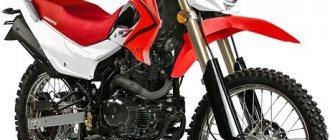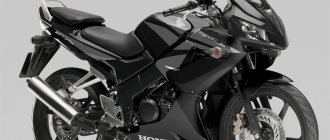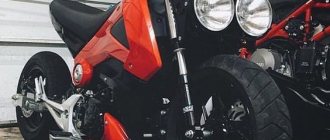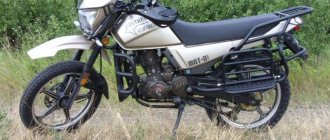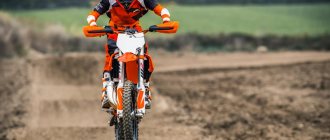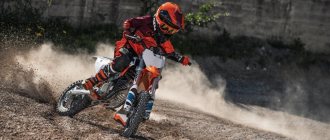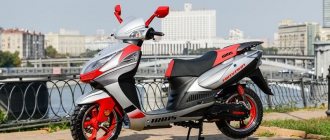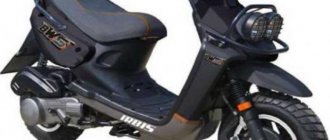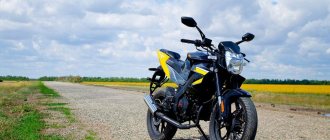Motorbike Irbis TTR 250 is an off-road enduro, positioned by the manufacturer in the motorcycle market as a cross-country motorcycle.
The official dealer and seller of this model in Russia is. The motorcycle is manufactured in China. Despite the existing shortcomings, which we will discuss below, as well as its Chinese origin, this full-fledged 250 cc enduro can be described as a fairly high-quality, technologically advanced, and most importantly inexpensive motorcycle in its segment.
Engine
The Irbis TTR 250 is equipped with a single-cylinder engine with a capacity of 250 cc. see air cooling. A similar engine was previously installed on the Japanese motorcycle Honda CB 250. According to its characteristics, the power unit shows good results: simply “mad” traction at the “lower” levels, and the maximum power is 17.7 hp. at 7500 rpm.
Transmission
The gearbox has 5 steps. The gears are generally well chosen, but a little short. The maximum speed in 4th gear is 50 km/h, and then speed increases only in the highest (aka 5th) gear. Gear shifting, unlike the younger model Irbis TTR 125, occurs according to the traditional scheme: first down all the way, slightly up - neutral, then second, third, etc. The gears engage clearly, without jamming.
Chassis: frame, suspension, brakes, wheels
The declared type of motorcycle as “cross” does not meet the expectations of fans due to the weak chassis and selection of stars. The TTR 250 can be called more of an enduro cross version. The stiffness of the suspensions is more suitable for quiet or near-sport driving on rural roads or light off-road conditions.
The frame is duplex, made of steel.
The front suspension is an inverted telescopic fork, non-adjustable, the rear suspension is pendulum, with a monoshock absorber and progressive characteristics, it is possible to adjust the length of the shock absorber.
Disc brakes with 2-piston calipers are installed at the front and rear of the bike. There are no complaints regarding their effectiveness.
The wheel rims are spoked and have sizes of 21 (front) and 18 inches (rear). The stock dual-purpose tires that were originally installed on the motorcycle perform well in snow, mud, sand, and water, but are not at all suitable for driving on asphalt.
Design, equipment, finishing elements
Irbis TTR 250 looks aggressive and sporty. Highly raised fenders, the absence of boxes for tools and other luggage, as well as a minimum of equipment make it clear that this is a motocross motorcycle.
As for the electrical equipment, I am pleased with the presence of a front headlight, which shines well and will allow you to comfortably drive home at night. The absence of rear-view mirrors, brake lights and other light signals is justified by the fact that the bike is designed for small jumps and riding on bumpy slopes, which, in turn, means constant falls and minor damage.
Among the finishing elements, I would like to note the hard seat made of foam rubber, as well as “fragile” Chinese plastic.
The new 2013 model (photo below) has corrected many shortcomings. For example, hand and steering wheel protection is installed, and there are rear-view mirrors. The latest version has lost the features of a real cross-country “device” and is more reminiscent of the classic design of enduro motorcycles.
New motorcycle Irbis TTR 250cc 4T 2013
Additionally
The design of the bike is not particularly complicated and is easy to maintain. Almost any breakdown can be “fixed” without professional skills. Reviews of the snow leopard ttr 250 leave an undeniable fact - it breaks quite often, but not critically. These are mainly “loose” connections, fuel leaks, problems with chain tension and other minor annoyances.
Spare parts for it can be bought almost everywhere, and they are relatively inexpensive. For those who like to improve and modify, the “field” is open for tuning a motorcycle, from strengthening the frame and replacing plastic fairings to boosting the engine and installing additional devices.
In terms of dimensions, the motorcycle is quite tall, so it is perfect for tall people (more than 170-175 cm).
The undoubted advantages, in addition to its price and availability, also include high ground clearance (220 mm), low weight (118 kg) and the absence of the need to register the motorcycle with the traffic police. A category A driver's license is also not required.
Irbis TTR250 and TTR250R
Side view.
On the asphalt.
Outdoors.
Side view.
Vladivostok engineers worked on the mistakes, listened to the opinions of experts, and a year later presented a modification - Irbis TTR250R , simultaneously adding several additional goodies to it.
But the advantages of the new product turned out to be so important that it grew from the category of modification into a separate model. The bikes still had some things in common, but the documentation, as well as the stock equipment, immediately separated them.
A detailed comparison of the models will be below, but here it is enough to note that when purchasing the first version, the user receives a sales contract and a refusal letter for traffic police inspectors, which clearly states that the motorcycle is sports equipment and cannot be registered. Naturally, if a rider is caught on special roads (public roads), a fine will follow.
Of all the documents, only the operating instructions.
The second model has received all the documents, and if you wish, you can register it, and having received your license, you can legally drive both on special roads and outside of them.
Positive Features
Among other advantages and characteristics of the Irbis GR 250, the following should be noted:
- non-adjustable telescopic inverted front fork with short-stroke rear pendulum monoshock;
- 17-inch alloy wheels with excellent road tires;
- durable and reliable braking system, which provides rapid speed reduction in any road conditions;
- high-quality instrument panel with original tachometer;
- 15-liter gasoline tank;
- standard lighting equipment, including a wide headlight, side reflectors and turn signals.
A more detailed description of the technical characteristics of the Irbis GR 250 motorcycle can be found in the operating instructions.
Specifications
Technical characteristics of Irbis TTR250 are presented in the instruction manual.
As the developers themselves admit, they ripped off the engine concept from Honda - the CB250 . The only change is a reduction in torque, and therefore an increase in overall thrust, starting from the bottom, but it still remains a “high engine”.
From the gearbox side.
Engine from the spark plug side.
Close up of the cylinder block.
- Type - 1 cylinder, 4 strokes.
- Working volume - 223 cm3.
- Marking: 166FMM.
- Power - 16 hp
- Number of valves - 4.
- Cooling - air;
- Fuel supply - carburetor.
- Ignition is electronic.
- Start - electric starter or kick starter.
- Tank volume - 8 l.
There are no complaints about the quality of gasoline - from AI-92 and above .
Transmission and clutch
The bike gets a 5-speed gearbox as standard. It doesn't cause any problems, it switches well.
The desired gear is located right away, and the neutral is located in the usual place - between first and second. When the engine is turned off, neutral is caught well. If you want to drive around the city, you will have to get used to finding neutral.
- Multi-plate clutch , oil bath, power transmission - cable .
- The main drive is a chain .
Brakes
The model is equipped with disc brakes on both wheels.
Front disc brake.
Rear brake. Here the tuning is two pistons.
Hydraulic drive, supported by 1 piston . No options are offered. It is interesting that the working hoses are reinforced . Some people change the calipers to 2 pistons. Availability of spare parts is very good.
Acquaintance
The 2013 Irbis GR 250 motorcycle is one of the most modern types of urban road vehicle. The model is made in an elegant, sporty style and, of course, has quite attractive technical characteristics, as well as a pleasant affordable price.
The stylish appearance of the motorcycle is accompanied by the bright and eye-catching colors of the cockpit provided by the Chinese manufacturer. After all, the Irbis GR 250 is available in yellow, green, red and blue colors, which fit perfectly with a black background and give the motorcycle a special aggressiveness and expressiveness. However, it should be noted that this bike has not only stylish and beautiful shapes, but also excellent characteristics for city riding. One has only to pay attention to its equipment, and everything becomes clear.
Driving performance
The maximum speed (measured by GPS) is 120 km/h, but it’s long and tedious .
Acceleration from standstill to 60 km/h - 5 seconds (GPS) . Up to 100 km/h - 16 seconds on stock stars. According to users - a normal cruiser - 80 km/h confidently, then extremely reluctantly with the ringing and grinding of the engine, transmission and everything else. Due to the lack of a balancing shaft, there is a slight vibration on the footpegs.
Fuel consumption
Gasoline consumption - 3.5 liters per 100 km . For a small-capacity model, the performance is not the best. For the cross version - within reason.
Buy a motorcycle Irbis TTR 250
The approximate price for which you can buy a new Irbis TTR 250 from retailers is in the range of 60-65 thousand rubles. It is advisable to contact the dealer through the official website before purchasing, find out details about the warranty and other important aspects, and only then make a purchase.
Prices for used (used) 2012 models start at 40 thousand rubles. As you know, the better the condition of the bike and the lower the mileage, the higher the price.
Review conclusion: Irbis TTR 250 is a Chinese cross-country enduro with a beautiful appearance and an attractive price. For those who like to ride through forests and fields, it will be perfect, but be prepared for possible unpredictable breakdowns during its operation.
An adequate price is based on the price/quality ratio. For comparison, more reliable new Japanese motorcycles with a similar engine capacity cost 2-3 times more.
TTR250 design
Since the model is intended for sports use, steel became the main material during development. To reduce weight and improve maneuverability (what distinguishes all Irbises), a tubular design was used.
- Another technological feature that was supposed to reduce weight, and therefore help the rider control the “iron horse,” was thin plastic . However, it was a miscalculation by the developers and if the frame can withstand falls, then the plastic has to be changed regularly.
- The suspension is carried out according to the standard design - an inverted telescopic fork , a pendulum on one spring in the rear (a very stiff spring) . But even such an ordinary design gives rise to criticism - the bike’s pendulum is frankly rather weak. This also includes the lack of ability to adjust any settings. And also the fact that the progression of the rear part depends only on the pitch of the springs (which probably should have affected the reduction in the cost of the motorcycle).
Exterior
The appearance of the crossover bike follows the canons of the genre - short wheelbase, high ground clearance, tires with an evil lug.
Front fork.
Rear tire mark on the ground.
Powerful rear tires.
Front end
- The first glance at the front part does not raise any questions. A fender pulled up just under the frame, and a small piece of plastic into which a small square headlight is inserted. According to users, it provides light, but it is not clear where it is directed.
- A sporty horned bullet on clip-ons and, as a continuation of the plastic, a small panel that, in theory, should cover the missing (on the cross-country) instrument panel.
- A more picky user will notice that the angle of rotation of the wing covers the front part of the bike, but the dirt raised by the wheel flies directly onto the air vent.
Ignition.
Front view.
Another perspective.
Control knob on the right. Starter button and engine stops.
Air intake for engine cooling.
Devices
As a rule, for cross-country versions there is no instrument panel at all. The TTR250 was no exception. Only the second generation bikes got their panel trained.
However, most resources have diagrams for installing a bicycle computer as an hour meter .
Back view
Long, sporty-sharp stem, long distance to the saddle, which is not designed for long-term sitting. And in front of him there is a large “lamb” under his arm - the gas tank cap.
- The capacity of the latter is 8 liters . For sports equipment that will live most of the time in the team’s garage, they did not separate the reserve .
- To the delight of the neighbors, there is no flute in the muffler, there is direct flow . The can itself hangs on the right side at approximately the level of the wheel hub.
Dimensions and weight
The dry weight of the motorcycle is 120 kg . By adding 9 liters (tank) and 1 liter of oil + all sorts of technical fluids - 130 kg equipped.
In terms of dimensions, you can’t call it a small-capacity model. The bike has:
- length - 2,191 mm;
- width - 821 mm;
- height - 1,230 mm;
Seat height - 930 mm .
For whom is it intended?
A fairly high seat position implies that the rider must be tall. According to reviews from bikers of average height, an uncomfortable saddle creates certain problems when maneuvering.
Good day to all readers. As you understand from the title, this is another review. But the most interesting thing is that this is not a review of the red-and-white Irbis TTR250 (2013) with PTS and an enduro-tourist design, but a pure cross-country bike. So to speak, improvements to the ’12 model. I’m shocked myself))) I invite everyone interested to the cat 
Let's start from afar:
After selling my TTR125, I was very homesick for off-roading, and given all my adventures with Duke, I was doubly homesick. And so it happened, it was decided to buy a 250th Irbis after the New Year)) I called the store, asked about the bike, and they told me that there is no PTS version and will only be available in a week, but they can bring the version without PTS even today. I thought and thought and decided that it was worth taking this one, since I essentially only needed it for the mud mixer. (Further in the text, in order not to repeat ourselves, the Red and White with PTS will be called: PTS version , the Blue and White 2013 will be called: without PTS , and the Irbis 2012 will be called: old version ). All 3 motorcycles, for clarity: 2012…………………………………………………………………………………………………………… …………………………2013 with PTS 2013 without PTS
Well, now let's proceed directly to the review of the motorcycle itself:
Performance characteristics: Unlike the PTS version, this one is lighter (125 versus 118 kg).
Also, the tank here seems to be 8 liters versus 12 for the PTS version, but at the gas station I could fit 9.2 liters, taking into account the fact that I had 1.5 liters splashing around there. Otherwise, these two motorcycles, like the old version, are similar in terms of performance characteristics. 1) As always, you can read the instructions and throw them away, you don’t read a lot of useful stuff there)) In general, the moto looks cool, big, tall, beautiful =) But outwardly, there are a lot of things that look beautiful, but you can also put the poop in wrap it up nicely.
2) Well, I picked it up, rolled it across the bare ice to the garage, and went home... yes, yes, it was just raining heavily and there was no desire to ride it. The next day, under a gray gloomy sky and some periodic drizzle, I went to the garage, adjusted all the switches to suit myself, and was especially pleased with the rear shock absorber that was tightened almost all the way. When I sat down for the first time, it was like sitting on a wooden bench. Yes, and the triggers are somehow pulled up very high, it’s very inconvenient, for whom it’s made like that, I don’t know. Well, I got dressed and went to refuel. Before refueling, I need to drive through all of Khimki, along Leningradskaya turn onto the Moscow Ring Road and after 200 meters there is a BP gas station (yes, I only refuel at them, I’m so pretentious, I’ve already forgotten how to hold a gun in my hands^^) In general , In the city this motorcycle is not an option at all. Why? Because the tires are only for off-roading and on the asphalt there are a lot of vibrations from them and it’s not comfortable to drive; it’s also difficult to pick up speed with them on the asphalt. Plus there is no lighting equipment or tidy. If the tidy is okay, then without lighting it’s scary and uncomfortable. And I constantly look in the mirrors, but THEY ARE NOT O_o! And each time, realizing this most terrible fact anew, I have to turn around completely, which also frightens me because I will miss the obstacle in front of me. And the brakes are weak, it’s scary not to have time to slow down. Generally disgusting. I apologize for the lack of video, GoProkha sat down, since I haven’t used it for a long time (((
3) It's time to take a breath and go off-road. But here we have to take into account that in the forest there is hellish ice everywhere, clean ice is better than on the skating rink that has turned into a puddle next to the house. I leave, drive 300 meters to the dirt road and let's go! Here it is, his element) Let's go. under the wheels there is ice, puddles, mud... an interesting mixture in general. Somehow we drive a hundred meters with drifts. Unusual, heavy, tall (saddle height 930! This is too much even for me, but I don’t seem to complain about short stature and short legs. I just don’t understand how people with legs shorter than my 910 can sit on it, and I can only reach the ground normally with my toes))) I rode, I got used to it, sometimes I stalled (the kickstarter sucked, I could never start it, even when warmed up, so I forced the electric starter), sometimes I fell... I fell a lot. We will talk about all the problems and losses of the first trip later, but for now about the pleasant things:
It pulls well, has enough power, and the tires grip surprisingly well even on ice. The seat is a little hard, but it’s normal for a cross-country bike, there’s no need for a sofa here, although my hips right next to the butt hurt a little, since I rode for 2 hours. In general, you feel like you’re on a full-fledged cross-country bike. A nice addition to the new model in the stock rear shock protection from dirt, on The old ones had to first farm it themselves.
The seat is a little hard, but it’s normal for a cross-country bike, there’s no need for a sofa here, although my hips right next to the butt hurt a little, since I rode for 2 hours. In general, you feel like you’re on a full-fledged cross-country bike. A nice addition to the new model in the stock rear shock protection from dirt, on The old ones had to first farm it themselves.
Well, a few more photos before the most important part of the post:
On the left of the steering wheel: a light button (low/high), the horn and turn signal buttons do not work for a simple reason: the absence of a horn and turn signals =) as well as choke control, convenient, no need to climb down to the carburetor. On the steering wheel on the right: a starter button, an emergency engine shutdown button and a headlight control button (3 positions) the headlight is not on, the parking light is on, the headlight is on. There was no one else to take a photo of me, so I apologize, but the photo is in TP style ^^
And now we come to the main thing! Jambs, problems, malfunctions and other pleasant little things: The first thing that was noticed was the crappy assembly, well, this is as always, nothing surprising. Some things are stretched well, others are almost not tightened at all.
Therefore, if you have time, your butt isn’t burning and it’s not winter with cold and dampness, but a pleasant warm summer, don’t be too lazy to go through everything you can get your hands on, screwdrivers and keys.
The second is this tricky assembly of the steering wheel and headlights:
I don’t understand what’s stopping you from putting a couple of two washers or one four under each mount.
Then, when I fell on my left side, another jamb came out: (I apologize for the quality)
Let me explain: the gearbox shaft is steel. The gearbox foot is made of silumin. I think you already guessed, right? In general, when it fell, the motor fell onto the gearbox foot and the splines on the foot entered into an unequal battle with the splines on the shaft. As a result, the foot now rotates on the shaft like..., well, you understand))) I need to change the foot to a normal one, steel, I’ll look for and select a foot, eh. And on the old TTR125 there was a steel foot, it’s not like they ran out of steel...
Then all sorts of little things were found, such as a scrolling left grip, which can be eliminated by wrapping an adhesive plaster; a long-stroke rear brake can also be eliminated by filing without problems. Also, the footrest is welded from the very bottom, which is not very logical, because it will collect all the stumps with itself, it would be digested, but not critical. As they also say, the air vent sucks water very well, it’s better to change everything there a little. I haven’t climbed there yet, so I can’t say anything. It's also fun to see these blinds on the left and right front. Well, of course, because on a Honda or Yamaha, from which the bike is licked, there is radiator airflow... but here... ah...
For those who think that the moto is copied from the Yamaha TTR250: this is not so, they are completely different, but what TyTyrchik was copied from is the Honda crf 250 (especially the red and white Irbis) Honda, for example:
If you compare carefully, you can find a lot of little things that distinguish Honda and Irbis precisely in the practicality of these elements and understand that the Irbis should break down precisely because of them. All these little things need to be corrected and modified (After assembly, process with a file =)
Almost a conclusion: I've driven around, I'm already getting ready to go to the garage, remove the gearbox tab and go home. But it wasn’t there, on a simple hill, completely icy (by the way, I was driving up it), I was driving down the edge, along the ground, and then the ground ended and I thought that it would be possible to slide smoothly and evenly without gas along the ice to the bottom and All. As soon as I go out on the ice, like at a skating rink I just spin around and hit the ice... it hurts, damn it -_- But the saddest thing is that the spendthrift now looks like this: Actually, what should have been expected sooner or later, although I hoped not to lose everything at once . As mentioned, the plastic here is very scratchy, you definitely need to buy a normal wing. Also, can anyone explain to me why there are holes in the wing? The photo shows it on the back of the wing. Although it all survived a surprising number of falls (7-8 pieces), the last one was just very juicy. What was funny was something else: he got out from under the moto, stood up and drove off, ahh, yes, he actually rode, on the ice, along with the moto. That's how we reached the ground. Very slippery ice in general.
I’ll say something about the headlight: It is mounted on two snotty plastic plates 2 mm thick... well, this is nonsense. On my old Irbis TTR125, the headlight was attached to the fork legs with good thick rubber clamps. Like this:
They held up super well and at the same time, when they fell, they won back and that’s it, without losses. Why do the Chinese replace good elements with unfinished ones, I don’t know. I’ll put two steel plates there and attach them securely, otherwise the plastic is crap)
Conclusion:
In general, my soul is happy, I wanted to ride so much that it’s just terrible)) But now, just in time for the start of everyday work, I will have to find time to buy all the elements and restore the functionality of the motorcycle) After all, soon there will be snow, and not this damned ice, and it will be possible to ride normally ) Everyone, treat the beaver with rays of goodness, of course, and a speedy season!
Comparison with Irbis TTR250R
- The main advantage of the new model has already been indicated above - the presence of a PTS . In addition to this, the bike has a full set of lighting equipment and mirrors, which will allow you to register it with the Traffic Police and calmly drive through special traffic regulations.
- Availability of instrument panel . It is minimal, but the tachometer/speedometer is present. In addition to them, for convenience, a gear indicator is installed, and there are also indicators for turning on neutral and high beam.
- Saddle . The new version is positioned as a touring enduro. Therefore, here it has been redone, two people can sit freely.
- The limits for tuning in the new version are unlimited. One rear shock absorber is offered in as many as 10 variations.
- Chain . According to user reviews, the new bike does not have problems with chain stretching. In any case, with use it sags over time, but its resource is significantly increased.
Flaws
However, the bike has few disadvantages:
- The chain stretches quickly . Can be replaced with a suitable Japanese version (according to reviews - Xonda SV250 and other variations of the SV line).
- The quality of electrics is a standard problem for the Chinese, but you can re-arrange or corrugate them yourself.
- Weak plastic and suspension are the main problems, but cannot be solved.
- Starter . Try to find a second-hand model with a working electric starter. It will be hard. The design is flawed; the gear that transmits force from the starter to the engine breaks. Standard problem.
Sometimes there is a high seating position, but for an off-road bike this is the norm.
and dignity
Small jump. I'm doing it. The editor-in-chief is trying the “250 tyr-tyr” thing.
Some of the advantages include:
- good motor (unpretentious and pulling);
- ease of maintenance;
- low fuel consumption.
In addition, you can add what distinguishes Chinese models:
- price;
- maintainability;
- large selection of components.
Irbis GR 250: customer reviews
Most motorcyclists who have had time to get acquainted with the new product note that the motorcycle, like no other, is suitable for driving in urban conditions. It picks up speed quickly, provides sufficient maneuverability and safe braking performance. However, in fairness, it should also be noted that there are more critical statements regarding this bike. For example, some motorists leave negative reviews for the Irbis GR 250. Among other things, there is a poorly mounted front fender (loose and almost impossible to fasten), faded LED turn signals, an unpleasant sound from the exhaust system, flimsy running boards and low-quality tools that come with the kit.

